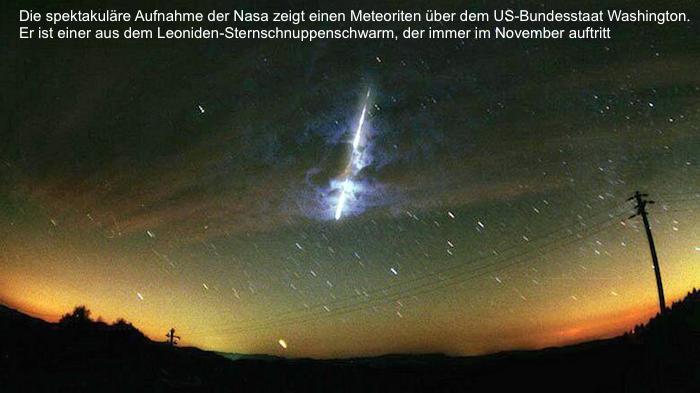15.11.2019

First a rocket launch Monday morning. Then a Mercury transit. And now area residents will get to witness another astronomical phenomenon this weekend when the Leonids meteor shower zoom through the night sky.
The Leonids — the major shower of the year — are bright colorful meteors traveling at speeds of 44 miles per second, which are some of the fastest meteors out there, according to NASA.
About every 33 years, stargazers can witness a Leonid storm that produces hundreds to thousands of meteors per hour, but the last one took place in 2002.
This year, the waning gibbous moon could interfere with viewing the shower, but viewers should still be able to see about 10 to 15 meteors per hour during its peak, which will happen Sunday night and early Monday morning, according to NASA.
Fortunately, according to the National Weather Service, those along the southern U.S., meaning those on the Space Coast and Treasure Coast, should have clear skies Sunday night, perfect for viewing the Leonids.
Originating from the comet 55P/Tempel-Tuttle, the Leonids appear to come from the constellation Leo. These showers are known for their fireballs — large explosions of light and color that last longer than a normal meteor streak — as well as for being earthgrazer meteors, which means meteors that streak close to the horizon and have long, colorful tails.
On the Space Coast, some of the best places to observe meteor showers include the beach access points along Cape Canaveral. Places like Jetty Park or Cocoa Beach are good locations as long as there is little to no light pollution and skies are clear.
NASA recommends laying flat on your back with your feet facing northeast and looking up to take in as much of the night sky as possible. For those looking to test out their astrophotography skills, meteor showers are great practice.
NASA suggests bringing a tripod and using a wide-angle lens to capture more of the sky. Photographers should also use a shutter release cable or the camera's built-in timer and try manually focusing their lens instead of using the auto-focus since the camera will have a hard time adjusting at night.
Quelle: Florida Today
+++
Sternschnuppen im November 2019: Leoniden leuchten am Himmel
Oft wird fälschlicherweise vermutet, dass es sich bei um hinabstürzende Sterne oder dessen Überreste handelt. Stattdessen handelt es sich dabei um Meteoriten, die in unsere Erdatmosphäre eindringen und dabei aufgrund ihrer hohen Geschwindigkeit eine gewisse Reibung erzeugen. Daraufhin verglühen sie und hinterlassen Leuchtspuren, die für uns letztendlich als Sternschnuppen - in diesem speziellen Fall als Leoniden - sichtbar werden.
Genau genommen sind die Leoniden Überreste des Kometen „Tempel Tuttle“, der seine Splitter im Sonnensystem hinterließ. Jedes Jahr im November kreuzt die Erde diese hinterlassene Spur, was uns das bewundernde Phänomen der vielen Sternschnuppen beschert.
Warum heißen die Sternschnuppen im November „Leoniden“?
Der Name „Leoniden“, mit dem man diese besondere Art von Sternschnuppen nennt, ergibt sich aus dem Namen „Leo“, was auf Latein Löwe bedeutet. Denn das Sternbild, das den Ausgangspunkt für die Leonidenschauer darstellt, ist das des Löwen. So entstand der Begriff für diese speziellen Sternschnuppen, die im November 2019 wieder zu sehen sind.
Leoniden erreichen am 17./18. November 2019 ihr Maximum
Allgemein kann man die Leoniden jedes Jahr im November beobachten. Die beste Zeit im Jahr 2019 ist die Nacht von Sonntag, dem 17. November, auf Montag, den 18. November. Denn dann erreichen die Sternschnuppen-Schauer ihr Maximum. Einen besseren Zeitpunkt, um die Leoniden am Himmel über Deutschland zu beobachten, wird es in diesem Jahr nicht mehr geben.
Die Leoniden sind den Menschen schon seit dem Mittelalter bekannt. Zu besonders starken Sternschnuppen-Regen kam es beispielsweise bereits in den Jahren 1799 oder 1833. Dieses Jahr gibt es allerdings eine eher geringe Fallrate.Die Experten rechnen mit 15 bis 25 Sternschnuppen pro Stunde. Dabei muss natürlich das Wetter mitspielen. Mehr Sternschnuppen als normal sind das natürlich trotzdem, aber vergleichsweise zu anderen Jahren wäre durchaus noch Potential da.
Quelle: Merkur.de

